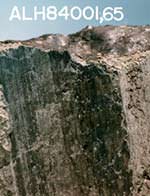
Image credit: NASA
University of Queensland researchers have confirmed the theory life once existed on Mars.
Dr John Barry, from UQ?s Centre for Microscopy and Microanalysis, together with former UQ researcher Dr Tony Taylor, found their proof in the water trap at the ninth hole of the Howestern golf course at Birkdale.
Mud samples from the golf course contained magnetic crystals which matched those found in a meteorite discovered in Antartica in 1984.
In 1996 NASA announced it had found primitive bacteria in that meteorite and since then debate has raged in the scientific community whether the organism were from Mars.
Dr Taylor, together with his PhD co-supervisor Dr Barry, examined the mud samples using a world-first breakthrough in electron microscopy and found the fossil bacteria and the new samples were identical.
?Tony developed a new technique to capture specimens for the electron microscope which allowed us to see through the bacteria and into the gel surrounding the magnetic crystals inside the bacterium,? Dr Barry said.
?This gave us a lot more information about the structure than what we would have seen before.?
Dr Taylor, who now works for the Australian Nuclear Science and Technology Organisation in Sydney, said this research seriously challenges doubts of sceptical scientists by discovering that many bacteria match the features found in the Martian meteorite.
?Our research shows that the structures found in the NASA meteorite were more than likely made by bacteria present on Mars four billion years ago, before life even started on Earth,? said Dr Taylor.
Dr Taylor said the discovery was the product of painstaking research conducted with other scientists in the 1990s that vastly improved imaging techniques to study bacterial structures. Ultraviolet light was the key and resulted in the detailed analysis of 82 different bacterial types – a major improvement on the 25 identified at that time.
?We became very excited when we discovered that many of the bacteria found had the same biosignature, which resembles a tiny backbone surrounded by cartilage, as that of the Martian fossils,? Dr Taylor said.
Emeritus Professor Imre Friedmann, one of the original NASA scientists to make the life on Mars claim said he was thrilled by the news.
?The Study of Taylor and Barry now presents evidence that the same features occur in a wide range of bacteria that live on Earth today. The tiny structures, chains of crystals of the mineral magnetite, are comparable to animal skeletons on a microscopic scale, ? Professor Friedmann said.
Dr Barry and Dr Taylor?s research was published recently in the Journal of Microscopy.
Original Source: University of Queensland News Release
